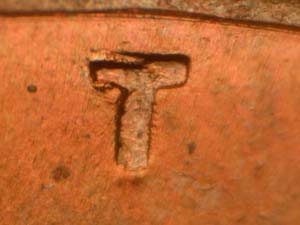
Doubled Dies:
Class VII: Modified Hub Doubling
Modified Hub Doubling
This coin exhibits hub doubling that occurred as a result of a modification of the hub. Several theories have been presented which include the grinding off an undesirable design element or a repair of a blundered master die. Since hubs are used to make impressions in thousands of dies, it would be a waste to throw out an otherwise perfectly good hub. So the undesirable design element is ground off and the resulting modified hub is used to make the initial impression(s) in the dies. A hub with the complete design is used to make the final hubbing of the dies. The doubling occurs when the undesired design element is not completely ground off and traces of the design still remain. These traces show up as doubling on the finished die even though a complete hub was used for the final impression. Since this form of doubling originates with a hub, several working dies will exhibit the same type of doubling. Several of the1970 Lincoln cents DDOs were first presented as from this type of doubling, but these can be successfully placed in other categories. This class has also been used to describe hub doubling that occurred as a result of the repunching of the final digit or two of the date into the master die. Recent studies, however, indicate that the digits were engraved into the master die rather than punched. Another scenario for this type of doubling occurs when at least one hubbing comes from a broken hub and another from a complete hub.
Last T of TRUST Notice how the doubling is limited to this single letter and that one of the images is broken
Date
Denomination Description
1941 1c DDO-012; 12-O-VII
5c None Listed 10c None Listed 25c None Listed 50c None Listed $1 None Listed
| Home |
Introduction |
Design Changes |
Mintmark Styles |
Doubled Dies |
Mintmark Varieties |
RPDs and MPDs |
Die Errors |
| About CONECA |
About the Author |
Copyright James Wiles, 2011
Email: jameswiles@sbcglobal.net
1490 Trail View Lane
Frisco, TX 75034-2649
